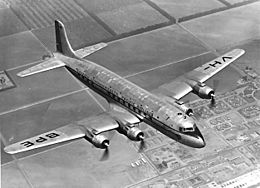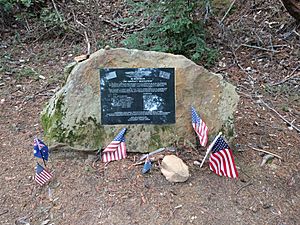BCPA Flight 304 facts for kids

The ill-fated VH-BPE.
|
|
| Accident summary | |
|---|---|
| Date | 29 October 1953 |
| Summary | Controlled flight into terrain |
| Place | San Mateo County, 3 miles WSW of Woodside, California 37°24′21″N 122°19′30″W / 37.405701°N 122.325119°W |
| Passengers | 11 |
| Crew | 8 |
| Injuries (non-fatal) | 0 |
| Fatalities | 19 |
| Survivors | 0 |
| Aircraft type | DC-6 |
| Aircraft name | Resolution |
| Airline/user | British Commonwealth Pacific Airlines |
| Registration | VH-BPE |
| Flew from | Sydney, Australia |
| 1st stopover | Fiji |
| 2nd stopover | Canton Island, Kiribati |
| 3rd stopover | Honolulu, Hawaii, United States |
| Last stopover | San Francisco, California, United States |
| Flying to | Vancouver, BC, Canada |
BCPA Flight 304/44 was a regular airplane trip. It was run by British Commonwealth Pacific Airlines. The flight went from Sydney, Australia, to Vancouver, Canada. It had planned stops in Fiji, Canton Island, Honolulu, and San Francisco. On October 29, 1953, a Douglas DC-6 plane called Resolution was flying this route. Its registration number was VH-BPE. The plane crashed while getting ready to land at San Francisco International Airport. All 19 people on board died. This included a famous American pianist named William Kapell.
Contents
What Happened to Flight 304?
This flight was traveling from Honolulu to San Francisco. There were 8 crew members and 11 passengers on board. This included 10 adults and 1 child. The flight was expected to take about 9 hours and 25 minutes. Captain Bruce N. Dickson, who was 34, and his crew took over the plane in Honolulu.
Both Captain Dickson and his First Officer, Frank A. Campbell, had flown the DC-6 plane many times. They had also landed at San Francisco Airport over 100 times. Many of these landings were done using only instruments. On October 29, 1953, the weather in San Francisco was foggy. Pilots could not see the ground, so they had to rely on their instruments to land.
Approaching San Francisco
As the plane got closer to California, the crew talked to air traffic control. At 8:07 AM, they were told to fly lower. They had to stay at least 500 feet (150 m) above the clouds. The crew confirmed they understood these instructions.
At 8:15 AM, the flight reported that it was starting to descend. They also received the latest weather report for San Francisco. A few minutes later, at 8:21 AM, air traffic control cleared the flight. They were to fly towards the San Francisco instrument landing system (ILS) outer marker. They were told to stay at least 500 feet (150 m) above all clouds. They also needed to contact San Francisco approach control after passing a point called the Half Moon Bay fan marker.
At 8:39 AM, the crew contacted San Francisco approach control. They said they were over Half Moon Bay. They were still 500 feet (150 m) above the clouds. About three minutes later, the crew reported they were "southeast, turning inbound." At 8:45 AM, air traffic control tried to call the flight, but there was no answer. All calls after that also went unanswered.
A local person named George Bordi heard the plane fly over in the thick fog. Moments later, he heard a very loud "crump" sound. This was the sound of the plane hitting the ground nearby.
William Kapell, a pianist from New York, was on his way home. He was returning from a concert tour in Australia. He was one of the 11 passengers and 8 crew members who died. Kapell was the only person from the United States on the plane. Most of the crew and 7 passengers were from Australia. Two passengers were from the United Kingdom, and one was from Canada.
Finding the Crash Site
Many hours after the crash, search teams looked for the plane. They had trouble getting through the thick woods at the base of King's Mountain. They reported that they could not find anyone alive.
Helpers from the Red Cross and emergency workers arrived. They worked to find bodies and parts of the plane. They also put out three forest fires that started because of the crash. The local sheriff's department used a building called the Redwood City Armory. It was used as a temporary place to identify the victims.
The body of William Kapell was quickly taken to his family in New York. Most of the other victims were returned to their families after being identified. Two people remained at Cypress Lawn Cemetery. Passenger William Cox was buried there. The ashes of purser Knight were placed in a special spot at the cemetery.
Why Did the Plane Crash?
The Civil Aeronautics Board investigated the accident. The investigation started right after the plane's wreckage was found. It was in a mountainous area southwest of San Francisco. The plane was almost completely destroyed by the impact and the fire.
The plane first hit the tops of several tall redwood trees. One of its landing gears broke off and got stuck in an oak tree. The plane then continued across a small valley. It crashed into the side of a steep hill. This crash site was about 1,950 feet (590 m) above sea level.
Investigators found that the landing gear was down and locked. This means it was ready for landing. There was no sign that the plane had any mechanical problems before it crashed.
The crash site was between two important navigation points. These were the Half Moon Bay Fan Marker and the San Francisco ILS Outer Marker. It seemed the plane did not stay at least 500 feet (150 m) above the clouds in this area. It had flown lower in foggy conditions, where the ground could not be seen.
Also, the flight reported being over Half Moon Bay at 8:39 AM. Then, at 8:42 AM, they said they were "Southeast, turning inbound." Investigators realized that the plane could not have flown that far in such a short time. This meant the pilot was likely southwest of the airport, not southeast, when he reported his position.
Investigators believed the captain might have briefly seen the ground through a break in the fog. Or, there might have been a mistake with the plane's navigation system. This could have made him think he was in a different, safer area. So, he started to fly lower.
The investigation concluded that the main reason for the crash was that the crew did not follow the correct procedures for landing in bad weather.
Remembering the Flight
Today, the crash site is part of the El Corte de Madera Creek Open Space Preserve. There is a path there called the "Resolution Trail." It is named after the plane. Visitors are asked to stay on the trail. They should also respect the site by leaving any old pieces of the plane where they find them.
On June 27, 2009, a special plaque was dedicated. More than fifty people attended. The plaque is near the Fir & Vista Point trails. This is close to where a military helicopter landed on the day of the crash.
The 65th anniversary of the crash was held on October 29, 2018. Alan Campbell, the brother of co-pilot Frank Campbell, flew from Australia to visit the plaque. He placed an Australian flag at the memorial. He also visited the exact spot where the plane crashed.
Images for kids



